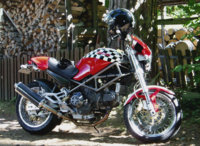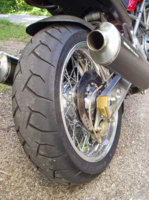Have a B -75... with 34 mm forks.
So, I bought a new pair of brake pads and they fit nicely in the caliber holes. But when putting back the wheel/rotor, there is not enough space between the pads for the rotor.
And no, it doesn't have to do with not squeezing the piston enough in. The pads are seated as much as they can.
And yes, the PO seemed to have swapped the forks, so the calibers ends up behind the fork instead of infront. If anyone thinks it look strange...
The rotor are 7 mm thick, the caliber the gap is only approx 11 mm wide and the brake pad is 8,8 mm thick (pad material is about 6,5). It seems that the rotor is too thick for this caliber.
EDIT: (BTW, the caliber on the image are fitted with the old brake pads. The new ones are on the other image, on the table.)
After searching info about discs etc. for xs650, it seems to exist also 5 mm. I only find 7 mm to be found for 77-84. Does anyone know which is the original disc thickness for a B -75? I can't believe it's 7 mm. Or could it be wrong calibers, maybe from another Yamaha? Or which other 5 mm discs from other models fit the wheel and caliber? Discs from SR500 and xs1100 seem to bolt right on, but does it fit correctly in the caliber?
And what would be the most easy and economical solution? To make an upgrade with new and better calibers or just grind off the existing rotors down to 5 mm or more? I have a local workshop near that may would be able to do it.
Cheers
So, I bought a new pair of brake pads and they fit nicely in the caliber holes. But when putting back the wheel/rotor, there is not enough space between the pads for the rotor.
And no, it doesn't have to do with not squeezing the piston enough in. The pads are seated as much as they can.
And yes, the PO seemed to have swapped the forks, so the calibers ends up behind the fork instead of infront. If anyone thinks it look strange...
The rotor are 7 mm thick, the caliber the gap is only approx 11 mm wide and the brake pad is 8,8 mm thick (pad material is about 6,5). It seems that the rotor is too thick for this caliber.
EDIT: (BTW, the caliber on the image are fitted with the old brake pads. The new ones are on the other image, on the table.)
After searching info about discs etc. for xs650, it seems to exist also 5 mm. I only find 7 mm to be found for 77-84. Does anyone know which is the original disc thickness for a B -75? I can't believe it's 7 mm. Or could it be wrong calibers, maybe from another Yamaha? Or which other 5 mm discs from other models fit the wheel and caliber? Discs from SR500 and xs1100 seem to bolt right on, but does it fit correctly in the caliber?
And what would be the most easy and economical solution? To make an upgrade with new and better calibers or just grind off the existing rotors down to 5 mm or more? I have a local workshop near that may would be able to do it.
Cheers
Attachments
Last edited:

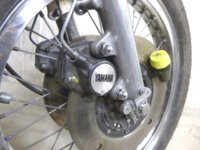
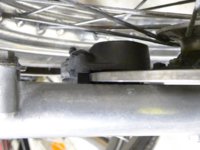
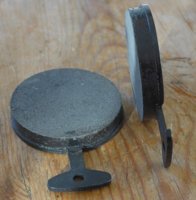
 I have the Clymer manual, but was so sure it was only one piston. Then perhaps, if both pads can be seated 1 mm more each, that may be enough. Didn't measure exactly while testing the new pads. Will do. It seems that i will go over the instructions I found earlier somewhere on the forum on how to repair calipers. BIG thanks, don't know what I would do without this place.
I have the Clymer manual, but was so sure it was only one piston. Then perhaps, if both pads can be seated 1 mm more each, that may be enough. Didn't measure exactly while testing the new pads. Will do. It seems that i will go over the instructions I found earlier somewhere on the forum on how to repair calipers. BIG thanks, don't know what I would do without this place.